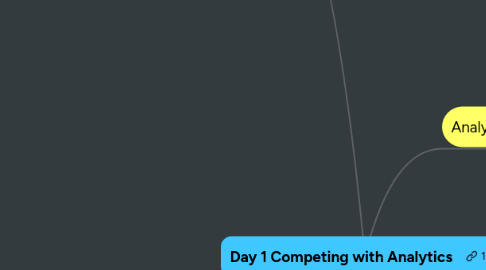
1. Quotes
1.1. The unexamined life isn't worth living - Socrates
1.2. The unexamined decision isn't worth making. -Davenport/Harris
1.3. Statistics are often used as a drunken man uses a lamppost -- for support rather than illumination. - Andrew Lang
2. Segmentation
2.1. National
2.1.1. Analytical Drivers
2.1.1.1. Situational Analysis / Drivers
2.1.1.1.1. What is driving us to do this?
2.1.1.1.2. SWOT Analysis
2.1.1.1.3. Customer Findings - What have we learned from customers?
2.1.1.2. Competitive Analysis
2.1.1.2.1. Do we have competitors and threats in these target markets with the proposed offerings?
2.1.1.2.2. What are our competitors doing and how are they positioning?
2.1.1.2.3. How do we position against each competitor?
2.1.1.3. Target Customer(s)
2.1.1.3.1. Buyer Profile
2.1.1.3.2. Influencer Profile
2.1.1.3.3. User Profile
2.1.1.3.4. What do customers want and need?
2.1.1.3.5. What business problems do each of these customers have?
2.1.1.4. Customer Segmentation
2.1.1.4.1. Which customers or sets of customers do we sell to?
2.1.1.4.2. What are the target market segments that we want to go after?
2.1.1.4.3. What are the distinct problems for each segment of the market?
2.1.1.5. Total Available Market
2.1.1.5.1. New Prospects
2.1.1.5.2. Existing Customers
2.2. International
2.2.1. Analytical Drivers
2.2.1.1. Situational Analysis / Drivers
2.2.1.1.1. What is driving us to do this?
2.2.1.1.2. SWOT Analysis
2.2.1.1.3. Customer Findings - What have we learned from customers?
2.2.1.2. Competitive Analysis
2.2.1.2.1. Do we have competitors and threats in these target markets with the proposed offerings?
2.2.1.2.2. What are our competitors doing and how are they positioning?
2.2.1.2.3. How do we position against each competitor?
2.2.1.3. Target Customer(s)
2.2.1.3.1. Buyer Profile
2.2.1.3.2. Influencer Profile
2.2.1.3.3. User Profile
2.2.1.3.4. What do customers want and need?
2.2.1.3.5. What business problems do each of these customers have?
2.2.1.4. Customer Segmentation
2.2.1.4.1. Which customers or sets of customers do we sell to?
2.2.1.4.2. What are the target market segments that we want to go after?
2.2.1.4.3. What are the distinct problems for each segment of the market?
2.2.1.5. Total Available Market
2.2.1.5.1. New Prospects
2.2.1.5.2. Existing Customers
2.3. Global
2.3.1. Analytical Drivers
2.3.1.1. Situational Analysis / Drivers
2.3.1.1.1. What is driving us to do this?
2.3.1.1.2. SWOT Analysis
2.3.1.1.3. Customer Findings - What have we learned from customers?
2.3.1.2. Competitive Analysis
2.3.1.2.1. Do we have competitors and threats in these target markets with the proposed offerings?
2.3.1.2.2. What are our competitors doing and how are they positioning?
2.3.1.2.3. How do we position against each competitor?
2.3.1.3. Target Customer(s)
2.3.1.3.1. Buyer Profile
2.3.1.3.2. Influencer Profile
2.3.1.3.3. User Profile
2.3.1.3.4. What do customers want and need?
2.3.1.3.5. What business problems do each of these customers have?
2.3.1.4. Customer Segmentation
2.3.1.4.1. Which customers or sets of customers do we sell to?
2.3.1.4.2. What are the target market segments that we want to go after?
2.3.1.4.3. What are the distinct problems for each segment of the market?
2.3.1.5. Total Available Market
2.3.1.5.1. New Prospects
2.3.1.5.2. Existing Customers
3. Predictive Modelling
3.1. Churn
3.2. Loyalty
4. Overview of Business Analytics
4.1. Analytical Problems and Decision Making
4.1.1. Benefits of being analytical
4.1.1.1. Help manage and steer the business in turbulent time
4.1.1.2. Know what's really working
4.1.1.3. Leverage previous investments in IT and information
4.1.1.3.1. more insight
4.1.1.3.2. faster execution
4.1.1.3.3. more business value in many processes
4.1.1.4. Cut costs / improve efficiency
4.1.1.5. Manage risk
4.1.1.6. Anticipate changes in market conditions
4.1.1.7. Have a basis for improving decisions over time
4.1.2. analytical
4.1.2.1. use of analysis, data, and systematic reasoning to make decisions
4.1.3. key questions
4.1.3.1. dimensions
4.1.3.1.1. Time frame
4.1.3.1.2. Innovation
4.1.3.2. questions (Fig1-1, p7)
4.1.3.2.1. What happened?
4.1.3.2.2. How and why did it happen?
4.1.3.2.3. What is happening now?
4.1.3.2.4. What's the next best action?
4.1.3.2.5. What will happen?
4.1.3.2.6. What's the best/worst that can happen?
4.1.4. where apply analytics
4.1.4.1. customer relationship management
4.1.4.2. supply chain
4.1.4.3. operations
4.1.4.4. human resources
4.1.4.5. performance management
4.1.4.6. finance and accounting
4.1.4.7. other
4.1.5. analytics not practical
4.1.5.1. no time
4.1.5.2. no precedent
4.1.5.3. history is misleading
4.1.5.4. decision maker has considerable expertise
4.1.5.5. variables can't be measured
4.1.6. decision making errors
4.1.6.1. Logic
4.1.6.1.1. not asking right questions
4.1.6.1.2. incorrect assumptions / not testing assumptions
4.1.6.1.3. use analytics to "justify" rather than let facts guide
4.1.6.1.4. fail to take time to understand alternatives
4.1.6.1.5. fail to interpret data correctly
4.1.6.2. Process
4.1.6.2.1. make careless mistakes
4.1.6.2.2. fail to consider analysis and insights in decisions
4.1.6.2.3. fail to consider alternatives
4.1.6.2.4. use incorrect / insufficient decision-making criteria
4.1.6.2.5. gather data or completing analysis to late to be of use
4.1.6.2.6. postponing decision because of data or analysis dissatisfaction
4.2. Gut Feel
4.2.1. 40% of major decisions are based not on facts, but on the manager's gut.
4.3. Analytical Assessment
4.3.1. Five Stage Model of Analytics
4.3.1.1. 1: Analytically Impaired
4.3.1.2. 2: Localized Analytics
4.3.1.3. 3: Analytical Aspirations
4.3.1.4. 4. Analytical Companies
4.3.1.5. 5. Analytical Competitors
4.4. Being Analytical
4.4.1. defined: the use of analysis, data, and systematic reasoning to make decisions
4.4.2. key is to be thinking how to become more analytical and fact based in decision making and to use the appropriate level of analysis for the decision at hand (p. 4)
4.5. Where to Analytics Apply?
4.5.1. customer relationships
4.5.2. supply chain and operations
4.5.3. human resources
4.5.4. finance and accounting
4.6. When are Analytics Not Practical?
4.6.1. When there's no time
4.6.2. When there's no precedent
4.6.3. When history is misleading
4.6.4. When the decision maker has considerable experience
4.6.5. When the variables can't be measured
4.7. Authors
4.7.1. Davenport, Thomas H.
4.7.2. Harris, Jeanne G.
4.7.3. Morison, Robert
4.7.4. Stubbs, Evan
